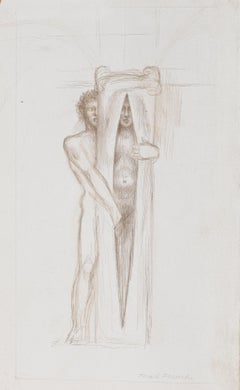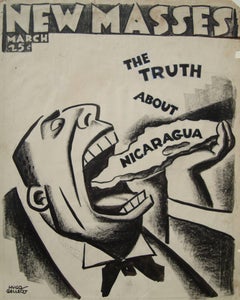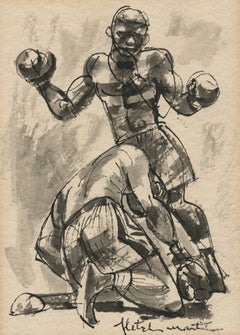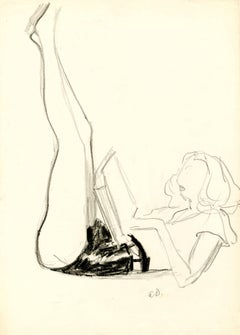Childs Gallery Figurative Drawings and Watercolors
to
1
1
2
Overall Width
to
Overall Height
to
4
2
2
2
4
2
2
1
1
1
1
1
1
1
1
1
1
2
1
1
1
1
1
1
2
1
4
Male Nude Releasing a Woman
By Jared French
Located in Boston, MA
Signed lower right: "Jared French". In fine condition.
Ex-collection Paul Cadmus; Jon F. Anderson and Philis Raskind-Anderson, Connecticut.
Exhibited: D.C. Moore Gallery, New York...
Category
Mid-20th Century Realist Nude Drawings and Watercolors
Materials
Silver
[Woman at a Table]
Located in Boston, MA
Frederick Bosley was an Impressionist painter of the Boston School who most often depicted portraits, figures and still-lifes. The artist was born in Lebanon, New Hampshire in 1881. He studied at the Museum School in Boston from 1900-1906 with Edmund C. Tarbell (1862-1938) and Frank W. Benson (1862-1951), and then in Europe from 1906-1908. Bosley returned to Boston in 1909, obtaining a studio at the Fenway Studios from 1909-1918. He was to become a teacher in his own right, settling as Director at the Museum School from 1913-1931. His many awards include First prize in the 1920 Concord Art Academy Exhibition and a Gold Medal in the Pennsylvania Academy of Fine Arts Exhibition, 1925. His work may be found in the collections of several institutions, including the Boston Museum of Fine Arts, the Farnsworth Museum, the National Academy of Design and the Concord Academy...
Category
Early 20th Century American Impressionist Figurative Drawings and Waterc...
Materials
Paper, Pencil
Newbury Street, Boston [Louis Boston / Bonwit Teller Building]
Located in Boston, MA
This watercolor by Charles Demetropoulos depicts a classical French Academic-style building which was designed in 1862 by architect William G. Preston as the new home of the Boston Society for Natural History, which had been founded in 1830. In the 1860’s, many of Boston’s cultural institutions relocated here to the Back Bay, the elegant residential district being built on the tidal marshes behind the city. When the museum moved here in 1863, the new building dominated the western edge of the landfill. The classical design reflected its role as a “temple of learning.” The building was later renovated into a women’s retail store known as Bonwit Teller and later became home to Louis Boston...
Category
Mid-20th Century American Impressionist Landscape Drawings and Watercolors
Materials
Watercolor
Study for "The New Masses"
By Hugo Gellert
Located in Boston, MA
Hugo Gellert (Hungarian-American, 1892-1985), Study for "The New Masses". Mary Ryan Gallery 4. Signed in ink lower left: "Hugo / Gellert"; inscribed in crayo...
Category
20th Century American Realist Figurative Drawings and Watercolors
Materials
Ink, Wax Crayon
Related Items
Untitled (Joe Louis knocking out Max Schmeling in 1938 rematch)
By Fletcher Martin
Located in Fairlawn, OH
Untitled
(Joe Louis knocking out Max Schmeling in 1938 rematch)
Pen and ink with wash on heavy wove sketchbook paper, 1938
Signed lower right: Fletcher Martin
Directly related to Martin's famous painting of 1942 entitled "Lullaby", which was also used in the lithograph of the same name. (see photo)
The drawing depicts the third and final knockdown of Max Schmeling in their rematch of 1938.
Condition: Mat staining at the edges of the sketchbook page edges
Toning to verso from previous framing.
Does not affect framed presentation
"It was here that Louis first used sport to bridge America's cavernous racial divide. With Hitler on the march in Europe and using Schmeling's victory over Louis as proof of “Aryan supremacy,” anti-Nazi sentiment ran high in the States. Louis had long grown accustomed to the pressures of representing his race but here the burdens were broader and deeper. Now he was shouldering the hopes of an entire nation.
A few weeks before the match Louis visited the White House and U.S. President Franklin Delano Roosevelt, whose tenure lasted even longer than Louis' would, told him, “Joe, we need muscles like yours to beat Germany.”
Those muscles certainly beat Schmeling on fight night...
Category
1930s American Realist Figurative Drawings and Watercolors
Materials
Ink
$4,000
H 13.5 in W 9.75 in
Eileen Lake
By Adolf Arthur Dehn
Located in Fairlawn, OH
Eileen Lake
Crayon on paper, early1930's
Initialed in pencil lower right (see photo)
Titled and annotated verso "Eileen Lake, early 1930s girlfriend"
Note: Eileen Hall Lake was an American poet and Adolf Dehn's girlfriend in the early 1930s.
Provenance:
Estate of the artist
By descent
Adolf Dehn, American Watercolorist and Printmaker, 1895-1968
Adolf Dehn was an artist who achieved extraordinary artistic heights, but in a very particular artistic sphere—not so much in oil painting as in watercolor and lithography. Long recognized as a master by serious print collectors, he is gradually gaining recognition as a notable and influential figure in the overall history of American art.
In the 19th century, with the invention of the rotary press, which made possible enormous print runs, and the development of the popular, mass-market magazines, newspaper and magazine illustration developed into an artistic realm of its own, often surprisingly divorced from the world of museums and art exhibitions, and today remains surprisingly overlooked by most art historians. Dehn in many regards was an outgrowth of this world, although in an unusual way, since as a young man he produced most of his illustrative work not for popular magazines, such as The Saturday Evening Post, but rather for radical journals, such as The Masses or The Liberator, or artistic “little magazines” such as The Dial. This background established the foundation of his outlook, and led later to his unique and distinctive contribution to American graphic art.
If there’s a distinctive quality to his work, it was his skill in introducing unusual tonal and textural effects into his work, particularly in printmaking but also in watercolor. Jackson Pollock seems to have been one of many notable artists who were influenced by his techniques.
Early Years, 1895-1922
For an artist largely remembered for scenes of Vienna and Paris, Adolf Dehn’s background was a surprising one. Born in Waterville, Minnesota, on November 22, 1895, Dehn was the descendent of farmers who had emigrated from Germany and homesteaded in the region, initially in a one-room log cabin with a dirt floor. Adolf’s father, Arthur Clark Dehn, was a hunter and trapper who took pride that he had no boss but himself, and who had little use for art. Indeed, during Adolf’s boyhood the walls of his bedroom and the space under his bed were filled with the pelts of mink, muskrats and skunks that his father had killed, skinned and stretched on drying boards. It was Adolf’s mother, Emilie Haas Dehn, a faithful member of the German Lutheran Evangelical Church, who encouraged his interest in art, which became apparent early in childhood. Both parents were ardent socialists, and supporters of Eugene Debs. In many ways Dehn’s later artistic achievement was clearly a reaction against the grinding rural poverty of his childhood.
After graduating from high school in 1914 at the age of 19—an age not unusual in farming communities at the time, where school attendance was often irregular—Dehn attended the Minneapolis School of Art from 1914 to 1917, whose character followed strongly reflected that of its director, Munich-trained Robert Kohler, an artistic conservative but a social radical. There Dehn joined a group of students who went on to nationally significant careers, including Wanda Gag (later author of best-selling children’s books); John Flanagan (a sculptor notable for his use of direct carving) Harry Gottlieb (a notable social realist and member of the Woodstock Art Colony), Elizabeth Olds (a printmaker and administrator for the WPA), Arnold Blanch (landscape, still-life and figure painter, and member of the Woodstock group), Lucille Lunquist, later Lucille Blanch (also a gifted painter and founder of the Woodstock art colony), and Johan Egilrud (who stayed in Minneapolis and became a journalist and poet).
Adolf became particularly close to Wanda Gag (1893-1946), with whom he established an intense but platonic relationship. Two years older than he, Gag was the daughter of a Bohemian artist and decorator, Anton Gag, who had died in 1908. After her husband died, Wanda’s mother, Lizzi Gag, became a helpless invalid, so Wanda was entrusted with the task of raising and financially supporting her six younger siblings. This endowed her with toughness and an independent streak, but nonetheless, when she met Dehn, Wanda was Victorian and conventional in her artistic taste and social values. Dehn was more socially radical, and introduced her to radical ideas about politics and free love, as well as to socialist publications such as The Masses and The Appeal to Reason.
Never very interested in oil painting, in Minneapolis Dehn focused on caricature and illustration--often of a humorous or politically radical character. In 1917 both Dehn and Wanda won scholarships to attend the Art Students League, and consequently, in the fall of that year both moved to New York. Dehn’s art education, however, ended in the summer of 1918, shortly after the United States entered World War I, when he was drafted to serve in the U. S. Army. Unwilling to fight, he applied for status as a conscientious objector, but was first imprisoned, then segregated in semi-imprisonment with other Pacifists, until the war ended. The abuse he suffered at this time may well explain his later withdrawal from taking political stands or making art of an overtly political nature. After his release from the army, Dehn returned to New York where he fell under the spell of the radical cartoonist Boardman Robinson and produced his first lithographs. He also finally consummated his sexual relationship with Wanda Gag.
The Years in Europe: 1922-1929
In September of 1921, however, he abruptly departed for Europe, arriving in Paris and then moving on to Vienna. There in the winter of 1922 he fell in love with a Russian dancer, Mura Zipperovitch, ending his seven-year relationship with Wanda Gag. He and Mura were married in 1926. It was also in Vienna that he produced his first notable artistic work.
Influenced by European artists such as Jules Pascin and Georg Grosz, Dehn began producing drawings of people in cafes, streets, and parks, which while mostly executed in his studio, were based on spontaneous life studies and have an expressive, sometimes almost childishly wandering quality of line. The mixture of sophistication and naiveté in these drawings was new to American audiences, as was the raciness of their subject matter, which often featured pleasure-seekers, prostitutes or scenes of sexual dalliance, presented with a strong element of caricature. Some of these drawings contain an element of social criticism, reminiscent of that found in the work of George Grosz, although Dehn’s work tended to focus on humorous commentary rather than savagely attacking his subjects or making a partisan political statement. Many Americans, including some who had originally been supporters of Dehn such as Boardman Robinson, were shocked by these European drawings, although George Grocz (who became a friend of the artist in this period) admired them, and recognized that Dehn could also bring a new vision to America subject matter. As he told Dehn: “You will do things in America which haven’t been done, which need to be done, which only you can do—as far at least as I know America.”
A key factor in Dehn’s artistic evolution at this time was his association with Scofield Thayer...
Category
1930s American Realist Figurative Drawings and Watercolors
Materials
Oil Crayon
1920's Peaceful Marsh Wetlands Watercolor Landscape with Birds
Located in Soquel, CA
Serene 1920's watercolor landscape of calm water snaking through a lush marshy wetland, dotted with small birds, wildflowers and swaying grass, by an unknown artist (American, 20th C...
Category
1920s American Impressionist Landscape Drawings and Watercolors
Materials
Paper, Watercolor
"Dragon, " Original Pastel Drawing
By Quang Ho
Located in Denver, CO
"Dragon," by Quang Ho, is a secondary market work with one previous owner. It is signed and dated (1988) on the lower left. The painting comes with it's original frame (measures 50 x...
Category
20th Century American Realist Animal Drawings and Watercolors
Materials
Paper, Pastel
Al Hirschfeld "Beat the Band" New York Times Broadway Theatre Illustration 1940s
By Albert Al Hirschfeld
Located in New York, NY
Al Hirschfeld (1903-2003)
"Beat the Band"
22 x 26 1/2 inches
ink on board
published in The New York Times, October 11, 1942
The unframed work comes directly from the Al Hirschfeld F...
Category
1940s American Realist Figurative Drawings and Watercolors
Materials
Ink, Board
1937 Academic Female Nude Charcoal Drawing "Head in Hand" UC Berkeley
By John Ayres
Located in Arp, TX
John Ayres
Head in Hand
May 1, 1937
Charcoal on Paper
25"x19", unframed $1250
Signed and dated in charcoal top right
*Custom framing available for additional charge. Please expect fr...
Category
1930s Realist Figurative Drawings and Watercolors
Materials
Paper, Charcoal, India Ink
NYC Subway Mid 20th Century American Scene Social Realism WPA Modern 1930s
By Daniel Ralph Celentano
Located in New York, NY
NYC Subway Riders Mid 20th Century American Scene Social Realism WPA Modern 1930s
Daniel Celentano (1902 - 1980)
Subway Scene, 1930s
8 x 9 inches
Ink and wash on paper
Singed lower ...
Category
1930s American Realist Figurative Drawings and Watercolors
Materials
Paper, Ink, Gouache
Violinist (Portrait of Young Man with Violin)
By Vito Tomasello
Located in Wilton Manors, FL
Outstanding male portrait by 20th-century American artist, Vito Tomasello.
Portrait of a Violinist, 1950.
Charcoal on paper, sheet measures 13 x 19 inches.
Signed lower left.
A ...
Category
1950s Realist Figurative Drawings and Watercolors
Materials
Paper, Charcoal
1930's Milford, CT Landscape -- First Church of Christ Congregational
Located in Soquel, CA
1930's watercolor figurative landscape depicting the First Church of Christ Congregational in Milford, Connecticut by J. Nolan of Providence, Rhode Island (American, 20th Century). S...
Category
1920s American Impressionist Landscape Drawings and Watercolors
Materials
Watercolor, Laid Paper
$451 Sale Price
35% Off
H 11.63 in W 25.63 in D 0.75 in
Portrait of Young Man
By Vito Tomasello
Located in Wilton Manors, FL
Outstanding male portrait by 20th-century American artist, Vito Tomasello.
Portrait of a young man, c.1950. Charcoal and pastel on paper, sheet measures an impressive 11 x14 inches...
Category
1940s Realist Figurative Drawings and Watercolors
Materials
Paper, Charcoal
House at the Beach, Baja California Figurative Landscape
By David Stephens
Located in Soquel, CA
Colors of tropical waters create a light and breezy mood in this figurative landscape watercolor by David Stephens (American, 20th century). Signed lower left, "D. Stephens." Present...
Category
1990s American Impressionist Landscape Drawings and Watercolors
Materials
Watercolor, Archival Paper
$584 Sale Price
35% Off
H 29.5 in W 37.5 in D 0.88 in
Untitled
By Mark Beard
Located in New York, NY
Charcoal with red and white conté crayon on Rives BFK paper
Signed and dated, recto
This artwork is offered by ClampArt, located in New York City.
Mark Beard, born in 1956 in Salt ...
Category
2010s Realist Figurative Drawings and Watercolors
Materials
Charcoal, Wax Crayon, Rag Paper

![fred bosley [Woman at a Table]](https://a.1stdibscdn.com/a_3973/a_139116321707237315466/CGL54384_40jpg_framed_master.jpg?width=240)
![bonwit teller boston Newbury Street, Boston [Louis Boston / Bonwit Teller Building]](https://a.1stdibscdn.com/a_3973/1687719736166/CGL58308_2_DS_jpg_master.jpg?width=240)


